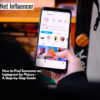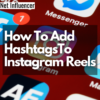Agency
How GIFTA Is Rebuilding Trust In Influencer Marketing
A recent study based on a survey of 1,000+ consumers revealed that 58% of Gen Z consumers trust gift recommendations from local or micro-influencers. Over a quarter of all respondents (28%) had purchased a gift based on an influencer’s recommendation in the year leading up to the survey.
Given its usefulness as a marketing tool, influencer gifting has become a popular strategy for many brands and platforms.
However, GIFTA’s influencer gifting model diverges from traditional influencer marketing: brands send products to creators without obligations yet receive 4x the industry-standard content output. This approach is delivering results for brands like Kellogg’s, Unilever, and Heinz..
Founded in 2020, GIFTA has grown to become one of the UK’s largest influencer gifting agencies by addressing what co-founder Tom Higgins identified as a paradox of influencer marketing: the mechanism designed to deliver genuine endorsements systematically removes honesty from the equation.
“I worked for another company and realized quite quickly that we’d reach out to these brands, and then the brands would reach out to the influencers,” Tom explains. “You’d say, ‘Who would like to raise awareness of this shampoo or these crisps?’ And the influencers would return and say, ‘I’ll do that, and I want £5,000.’ What would follow is a contract with strict dos and don’ts. The whole thing just is not authentic.”
This observation revealed a structural problem in the industry. As influencer marketing matured, it adopted many conventions of traditional advertising—controlled messaging and contractual constraints—undermining the genuine voice that made creator content valuable.
“I think there’s been a negative connection to the word ‘influencer’ in the UK,” Tom notes. “Consumers now think of influencers in a negative light. They want to hear from real people with real opinions on real products and services.”
The GIFTA Model: Trust Through Freedom
GIFTA’s solution is based on a simple principle: remove the money and contracts from the initial brand-creator interaction.
The platform puts products into the hands of thousands of micro and nano influencers (those with roughly 1,000-30,000 followers), handles all fulfillment and delivery logistics, and operates with a straightforward proposition to creators.
“We have a really simple model at GIFTA: if the influencer loves the product, they’re free to share about it. If they don’t like it, they just have to tell us why they don’t like it so the brand can learn from that,” Tom states. “This is at the foundation, a model just to drive trust in everything we do.”
This approach contrasts with industry norms, where, as Tom notes, brands typically see only 10-20% of gifted influencers post about their products.
“Our post rate at GIFTA averages about 85% across all of our campaigns,” says Tom. “If they love it, they share it. If they don’t love it, they tell us why they don’t like it. And if they don’t do either, we remove them from the platform and won’t work with them again.”
Micro-Influence: The Power of Close Connections
Data from GIFTA’s work with over 12,000 influencers last year revealed a surprising insight: Creators with smaller followings consistently generate better performance than larger accounts.
“Anyone that has 1,000 to 5,000 followers is by far the best-performing influencer we’re seeing at GIFTA at the moment,” Tom explains. “We believe it’s because they have up to one degree of separation between them and their audience. I could have 2,000 followers and post about something, and my friends know me directly or through somebody else or my family. I’m highly trustworthy within my circle of friends.”
This finding challenges the industry’s focus on reach and suggests that close audience connection may be more valuable than audience size. When GIFTA started, their minimum requirement was 5,000 followers per influencer, but they’ve since found that sub-5,000 follower accounts often deliver superior results.
“When you apply scale to that,” Tom continues, “then all of a sudden, the impression volume on micro and nano influencers that are much more connected and trustworthy to their audience is more valuable than the impression from somebody that doesn’t know their audience.”
From Media Buy to Relationship Building
Rather than treating creators as media channels to be purchased and controlled, GIFTA’s model positions them as consumers first and content creators second.
“We forget that marketing goes two ways,” Tom explains. “Most of the time, brands separate this. They’ll spend a lot of money advertising their products with influencers on billboards and digital marketing out-of-home print. And then they’ll spend a lot of money separately on market research and intelligence. But, micro-nano influencers with gifting, being truthful, can actually give us so much more wealth of information.”
This perspective transforms the initial gifting campaign into a first step rather than a transaction.
“Once the influencer is showing love to the brand and the brand’s showing love to the influencer, then that relationship can develop in the future,” says Tom. “But if we start the relationship with money and contracts, are we setting ourselves up for failure? Do we honestly believe that influencer truthfully loves that brand and product, or are they just interested in the money?”
The Business Model: Efficient Scale
GIFTA operates on a credit system that covers campaign management, logistics, distribution, reporting, and ROI analysis in one transparent fee structure.
“The business model is fairly straightforward. GIFTA works on a credit system,” Tom explains. “Brands will come to us, and they will say, ‘We want X amount of influencers.’
The minimum is 100 influencers that you can purchase from GIFTA, and you can spread that out between one or two campaigns, and then it goes up from 500 to 1,000 to 5,000 to 10,000.”
For larger brands, this approach enables them to test across multiple product lines and audiences throughout the year.
“Many bigger brands want to gift to many influencers throughout the year. So they will purchase credits from us and then spread it out strategically across all their brands throughout the year to gain economies of scale,” Tom says.
After identifying which creators generate the best results, brands can establish ongoing paid relationships or purchase rights to particularly effective content—creating a second revenue stream for creators.
“We want to make it easier for brands to purchase the rights of the content from the influencers and make sure the influencers are paid for their work if they decide they want to sell their rights to their content,” Tom notes.
Insights Beyond Impressions
GIFTA’s value extends beyond content generation to the consumer insights that emerge when creators engage with products on their own terms.
“When we gift to a thousand influencers, we usually receive around 3,000 pieces of content,” Tom says. “We analyze the caption, the comments, and the conversations between the influencers because they’re not like big influences in terms of where they’ll post, and they won’t necessarily interact. These influencers are having micro conversations with each other.”
This pool of unscripted content gives brands intelligence, transforming marketing campaigns into market research opportunities.
Tom provides a concrete example of this dual value: “One campaign that jumps out to me was the one we did with Heinz and Absolut Vodka. We sent out a new pasta sauce to 150 influencers, generating 550 pieces of content. And then three or four pieces of that content went viral. Wee got over 8 million impressions from it.”
But the value transcended these metrics: “They were going out and buying extra ingredients; they were mixing it in different ways. And that’s where you start to see the magic of influencer gifting and seeding because we’re not controlling output. You get to see variety, and you get to learn.”
Expanding Creator Participation
Tom predicts the trend toward genuine creator content will accelerate, with brands increasingly working with creators with even smaller followings.
“I think we’re going to see lots of brands go under a thousand followers soon, turning more consumers into influencers,” he says. “I’m seeing a lot of that movement in the UK.”
In the immediate future, GIFTA will enhance its reporting systems and test its expansion into European and U.S. markets. “This year is an exciting one. We’re very much evolving our reporting systems. We’re moving from traditional influencer metrics to understanding the value from the content that’s been created,” Tom says.
For Brands Considering Influencer Gifting
“Make sure you spend time to get the product into the hands of the right people,” Tom advises. “Don’t just blanket send to everybody. Make sure those influencers have said they’re interested in receiving the product. Allow them the freedom to create the content in their own unique way and their own unique style and use it as a way to listen and learn from them.”
This approach, Tom adds, not only yields better content but also valuable insights: “If we allow the influencers to tell us how they feel about the product in a truthful, trustworthy manner, we all get to learn.”
For GIFTA, genuine creator expression isn’t just an ethical consideration—it’s a business advantage.
“Show brands love, allow them to show you love, and then it will allow you to have a fantastic relationship in the future,” Tom concludes. “But when we jump straight into money and contracts, it’s just not the best start to the relationship.”















